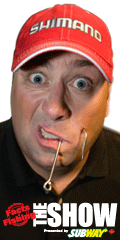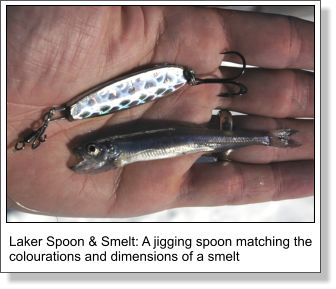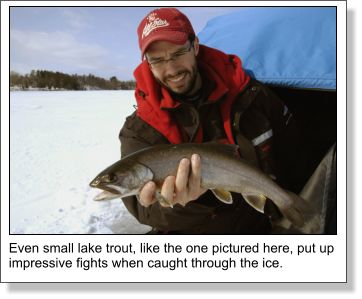


Editors & Publishers
T.J. & Monique Quesnel
The
Ontario Fishing Network
E-Magazine is
published 12 times a year on or near the beginning of every month. Our
magazine is geared to any angler who enjoys fishing of any type in the
wonderfully diverse province of Ontario.
Editorial Submissions: We welcome query letters,
but assume no responsibility for unsolicited materials.
Subscriptions: Subscriptions are FREE of charge
and delivered via email. You can subscribe
HERE:
Privacy Policy: Unlike other publications We
NEVER make our subscribers list (your email address) available to any
other companies.
Advertising: If you are interested in advertising
please email us.
Circulation - 8,200 email subscribers
© 2008 Due North
Marketing / Ontario Fishing Network / T.J. Quesnel. All rights
reserved. Reproduction of any material without prior written
permission strictly prohibited.
Total
Snowshoes
|
 Run
and Gun Ice Lake Trout Run
and Gun Ice Lake Trout
By Tim Allard
When winter wraps its cold grip over the landscape, a lot of
underwater life slows down. Warm-water fish get lethargic. This is
not the case for cold-water species, like lake trout. Lakers prefer
frigid waters. They aggressively feed and are frequently on the move
in winter. To succeed at finding and catching these silver, spotted
fish, adopt a run-and-gun approach. For any angler, catching a few
wintertime lake trout will surely shake off a case of the winter
blues.
Get Mobile and Cover Water
Think of fishing lake trout through the ice like running-and-gunning
for summertime bass. The objective is to cover water searching for
active fish. On the ice a portable ice hut is your bass boat.
Portable huts hold your gear and make moves easier. Teamed with an
ATV or snow machine moving long distances is easy. Portable ice huts
also protect you from wind and snow. This is important not only from
a safety perspective, but when youíre comfortable you fish more
effectively.
Winter Disposition and Food
Lakers are frequently hunting beneath the ice. No longer imprisoned
by the summer thermocline, they roam a variety of depths. Be
prepared to fish the entire water column. Lakers will swim a
distance to strike a lure, so it wonít take long to determine if
there are any in the vicinity.
Content with cold-water temperatures food is the main factor
influencing lake trout location. On a lake I fish, youíre sure to
find lake trout when you mark schools of smelt on your electronics.
Trying to figure out where smelt and lake trout are on a lake can be
intimidating, but it doesnít have to be if you do some homework and
study a hydrographic map.
Focus on Structure
Trout work in a pack, herding and ambushing their prey. They
frequently trap their forage against structures, capturing
disoriented baitfish. Keep this tactic in mind when studying a map.
Top structures to fish for lakers are the following: off shore
reefs, saddles and spines. Significant breaks on these structures
make them even better. Underwater narrows and other funnelling
structures are other good spots.
Remember, lake trout and their forage are moving more than
sedentary, warm-water fish species, so you need to cover water to
find them. Donít discount a spot if unsuccessful the first time you
fish it. When fishing a new lake, try the same area a few times
through the day. If you mark baitfish on your electronics fish them
thoroughly. If not, make it a quick visit and aggressively work
baits. If after jigging a few holes you donít hook any fish, move to
the next area.
 Laker
Baits Laker
Baits
View lake trout lures as search lures. Flash, rattles,
bright colours and a lot of action are the traits of good baits.
Carry fairly heavy lures to easily work deep water.
Swimbaits, spoons, and airplane or glider jigs are all prime baits
for lake trout. White, silver, light blue and grey are good colors.
Hot color highlights can add even more appeal. Glow paint can also
be deadly.
Lake trout hits are often aggressive. Some factory trebles on
jigging spoons and swimbaits wonít stand up to their jarring hits or
drag-peeling runs. Replace hooks with high quality ones and be
assured theyíll stick when you set the hook.
Swivels with quality ball bearings are another important piece of
terminal tackle for lake trout. They keep twist out of line when
youíre rapidly working baits. Snap-swivels let you quickly change
lures.
Lake Trout Gear
 You
need strong rods and reels with smooth drags to absorb the spunky
fight of lakers. Medium-heavy to heavy action rods are good and help
you snap jigging baits all day. Use spinning or a baitcast rods.
Spool the respective reels with at least 10 pound-test line. I like
superlines for these fish. You
need strong rods and reels with smooth drags to absorb the spunky
fight of lakers. Medium-heavy to heavy action rods are good and help
you snap jigging baits all day. Use spinning or a baitcast rods.
Spool the respective reels with at least 10 pound-test line. I like
superlines for these fish.
You want a reel with decent line capacity to fish deep water. You
may be 45 feet down when you hook a fish and it decides to peel off
a bunch of line. Low-grade ice fishing reels sold on many rod-reel
combos wonít handle lake trout runs. Use quality ones with smooth
drags.
Targeting lake trout through the ice is one of the most exciting
forms of winter angling. These fish aggressively hit lures and put
up impressive fights. Catching several lakes through the ice will
leave a good impression with any level of angler.
|